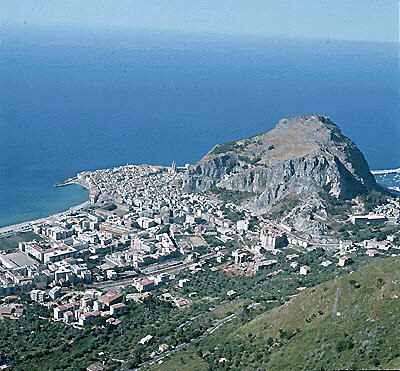![]()

In their vivid account of the great migration of people from Italy into the The United States of America, Jerre Mangione and Ben Morreale (La Storia, 1992; NY; Harper-Collins) report that 1.5 million persons left Sicily. Thus, 40 percent of the island's population left their homes to settle elsewhere. The majority of those people came to The USA.
In 1860, Garibaldi correctly assessed the weakness of the Bourbon kingdom, and landed his force, The One Thousand on the west coast of Sicily, at Marsala. The Sicilians were ripe for revolt. With the help of the island's population, Garibaldi swept through the countryside, crossed into Calabria, and marched his followers into Naples. He took over the control of The Kingdom of Naples and Sicily, and shortly thereafter he turned his conquest over to Victor Emanuel, who later became king of the country of Italy which emerged from uniting the various states and principalities of the Italian peninsula.
After the unification the Sicilians, who had been so enthusiastic about throwing out the nobility and the royal officials, suffered one after another disappointment. The country was poorly organized for the development of trade and industry. The nobility which had controlled vast tracts of land had failed to develop efficient and productive agriculture. The island lacked natural resources, except for sulfur, which was in demand all over the industrial world. Then, the mining industry in Texas developed very efficient methods of extracting sulfur from earth. Prices dropped drastically. Sicily's Even the subjecting a helpless labor force to the abominable measures graphically portrayed by writers Giovanni Verga , the leaders of the industry lost their markets to the Texas sulfur producers. Sicily's sulfur industry practically disappeared.
By 1893, 23 years after the unification, the island's population was on the brink of revolt. The central government sent in troops, under the command of General Mara. General Mara proclaimed a state of siege, and began a systematic repression of the leaders who had tried to organize the workers.
The people then turned their revolt into a different direction. They left their homes.
The Sicilians, like other Italian immigrants, tended to settle in towns and cities in which they could maintain associations with their paesani. The city of Albany, NY, became a favored destination of people from specific sections of Italy. A large share of Albany's Sicilian-American population originated from families who emmigrated from the area of Cefalu. (see photo of Cefalu, above. Note that it is easy to imagine the huge rock as a head -- a "cephalis;" having to do with the head.) Another large portion of the Sicilian-American population came from area surround Mount Etna.
Also, like other Italian-Americans, many Sicilian-Americans have reestablished contacts with those members of their families who now live in Sicily. Those who return to visit family members find a Sicily that is very differnent from the Sicily which was left behind by their immigrant forebears. Today Cefalu, a city of great beauty and historic significance, draws tourists from all over the world. Albanians who have the opportunity to return frequently to visit friends and family in the area of Cefalu easily become the targets of our envy!!!
Go to Top of this page
Return to List of Italian-Americana Information topics.
![]()
|
Anyone interested in obtaining a printed copy of this essay may change the print size by going to the view menu, and then instructing the program to print the text. It would be advisable to set the printer to print in black ink. |
| . The author, Jim Mancuso died on June 10th, 2005. We maintain this site in memory of all the things that he did for us. |
Go to Top of this
page
Return to List
of Italian-Americana Information topics.